The New HTC U12+ Smartphone Hands On
by Ian Cutress on May 23, 2018 5:35 AM EST- Posted in
- Smartphones
- HTC
- Squeeze
- Snapdragon 845
- HTC U12
- U12+
- Boomsound
- Quad Camera
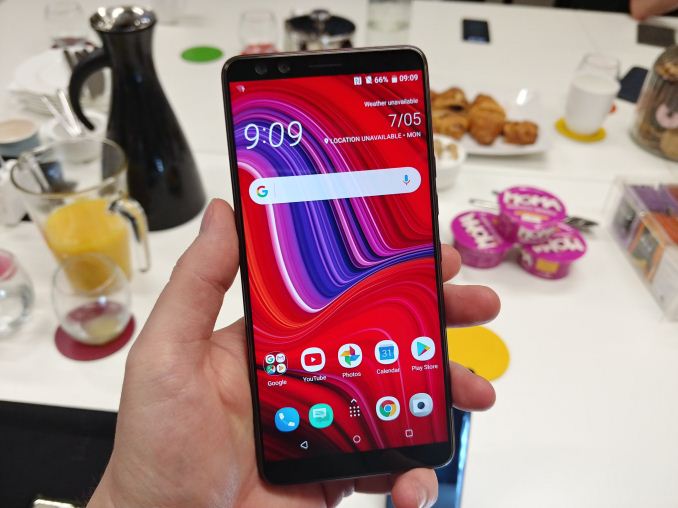
After the latest deal with Google on personnel, the next flagship out from HTC is the U12+, succeeding the squeeze-focused U11 and U11+ from 2017. For this generation HTC will only launch a single model called the U12+, rather than a U12 now and another one later, with the company citing that it felt too many of its enthusiast users would wait for the plus model, so instead they have decided to just go with a singular unit with the upgraded name. The headlines on the U12+ include a quad camera design, an upgraded Edge Sense detection system, a Qualcomm Snapdragon 845 SoC, an IP68 ingress rating, and an upgraded BoomSound experience. We had the chance to get a hands-on with the device at a briefing last week.
Two Cameras? Or One? We’ll Stick With One. No Four!
The new HTC U12+ attacks many angles of the modern design philosophy of a smartphone, one of which is the camera design. Several generations ago, HTC had one of the first dual camera systems in a smartphone, but the company says that at the time the ecosystem around dual cameras was not mature, and users were put off with the learning curve surrounding a dual camera system, and as a result they focused on a single camera implementation. As with the U11 system last year, HTC were still focusing on single camera designs and trying to get the best out of them, with the DXOMark score of the U11 used in the promotional materials as a highlight. With the U12, the DXOMark overall score is 103, but this time is through the quad-camera implementation in the smartphone. There are two cameras on the front, and two on the back. HTC stated that this is ‘probably the best dual camera ever tested’ (but notes that DXOmark does not take into account audio quality or selfie cameras, which it feels it would do well on).
The two main cameras start with an f/1.75 aperture 12MP wide-angle sensor with 1.4 micron pixels using HTC UltraPixel 4 technology for faster focusing, paired with a 16MP telephoto sensor at 1.0 micron pixels and an f/2.6 aperture. The rear camera arrangement supports OIS and EIS, and with the two sensors the camera supports a bokeh effect in real time. Optical zoom up to 2x is supported, with an enhanced 10x digital zoom that adjusts the in-shot processing characteristics based on the level of zoom; HTC was quite happy to show the difference between a cropped 2x optical zoom and a 10x digital zoom, with the 10x digital zoom having a lot more detail. The rear cameras use HTC’s HDR Boost 2, which uses more inter-frame data with the aim of a better HDR experience. A Pro mode with manual controls is available, with RAW format and exposure times up to 32 seconds supported. Video is up to 4K60, and can take 8MP photographs during video, or 1080p240 in slow motion. HTC’s video recording mode also uses the Sonic Zoom technology that we saw on the U11, using the four inbuilt microphones to triangulate the focal sound of the frame and reduce background noise.
The two front facing cameras are dual 8MP f/2.0 sensors with 1.12 micron pixels. They are set up to provide an 84º ‘wide-angle’ experience, and use the same tools as the rear cameras to implement a real-time bokeh effect. The front cameras also support the HDR Boost technology, and for low-light selfies the screen becomes super bright to compensate for an LED flash.
Perhaps the most important aspect to the front facing camera is that the smartphone can detect when users are laying down and using the smartphone in portrait mode. Rather than having to disable the rotate view option every time, HTC states that their system can identify how the device is being held along with the position of a face to determine when a system should rotate the display, or not in this case. This can be very useful – personally I have rotate display disabled unless it is specifically needed for this main reason.
BoomSound+
HTC has focused a lot on audio over the years, focusing on volume and clarity through its BoomSound technology. For the U12+, the upgrade comes in HTC supporting a Hi-Fi edition of BoomSound, with aptX HD and Hi-Res Audio recording and certification. As mentioned above with the cameras, this allows for Sonic Zoom to home in on a focal audio source, allowing for 60% better audio capture range before clipping and HTC claims ‘33% better focus’. For playback, HTC puts the latest edition of BoomSound as 50% louder than the previous flagship smartphone, with the dual speakers acting independently as a woofer for low frequencies and a tweeter for higher frequencies, with each speaker having its own amplifier.
There is no 3.5mm audio jack, but HTC does bundle the smartphone with its Type-C USonic headphones that provide active noise cancellation as well as unique equalizer adjustments depending on the shape of an individual’s aural canals.
Squeeze Me More: Edge Sense 2
In the last generation, HTC introduced the ‘squeeze’ as a way of interacting with a smartphone. Due to edge sensors placed on the edge of the bottom half of the phone, a user could short squeeze the device to trigger an action, or long squeeze for a different action. This was called Edge Sense, and for the new U12+ smartphone, users are treated to Edge Sense 2.

HTC U12+ on the left, Honor 10 on the right
HTC stated that for the first generation, Edge Sense was more like a camera button, but the second generation now has the software stack to improve its utility. More gestures are supported, such as frame tapping, and the device can determine which hand is being used in order to adjust how buttons are arranged for using the phone with a single hand.
The new software stack also allows for in-app customization. Users can ‘train’ (a fancy word for configure) the different gesture methods with Edge Sense 2 to relate to specific actions on any app, as long as those actions relate to touching the screen in specific places. The example given is that in Pokémon Go, a short squeeze could open a required menu.
Here’s the slogan HTC wants you to remember: ‘Live on the Edge’. One quote from our briefing is telling about how HTC is viewing this technology: ‘There will be a time where the touch screen will not be the leading way to interact with a smartphone’.
Alongside Edge Sense 2, HTC also adjusted the side buttons on the smartphone. Instead of physical buttons, these have turned into pressure sensitive buttons for power and volume, but with haptic feedback. The haptics are fixed (no options to enable/disable or change intensity), but there are physical raised parts to the frame such that the user can fumble in their pocket to turn the volume down. However, there is no physical depression of a button, which was initially quite unnerving.
The Fundamentals: BoomSound Means No Notch
For the back of the box specifications, the U12+ is a 6-inch smartphone with a 2880x1440 display (537 pixels per inch) using a SuperLCD 6 panel backed with Corning Gorilla Glass (version not specified). HTC lists DCI-P3 and sRGB color gamut support, but did not state how much of the gamut is supported. The display will support HDR10 content on YouTube, and although no number was mentioned, the display is likely to be 600+ nits at full brightness. HTC stated that they use a cold polished 3D glass technique for the U12+, which adds a couple of extra steps to reduce bezel thickness.
HTC had to go with an 18:9 display because of their audio technology: as BoomSound requires additional grills for speakers, as well as the microphone implementation, a notch based design is practically impossible, and as a result HTC is unlikely to make a 19:9 smartphone with a notch.
Powering the smartphone is Qualcomm’s Snapdragon 845 SoC, as with most other flagships this generation. The 6 GB memory and 64 GB storage configuration will be available worldwide, and a 128 GB storage model will be available in Asia only. There will be single SIM and dual SIM variants depending on the region and carrier, and microSD cards up to 2 TB are supported (although 400 GB are the highest ones you can realistically buy right now). HTC confirmed that they are using UFS 2.1 class storage through the lifetime of the device, and memory is LPDDR4X (although frequencies were unknown in our briefing).
The HTC U12+ will come with an IP68 ingress rating, with HTC stating that due to the Edge Sense technology, the buttons are fully workable underwater. Due to the Gorilla Glass and cold polishing technique, HTC also claimed 10x durability of the device.
| HTC U-Series | |||||||
| AnandTech | HTC U11 | HTC U11+ | HTC U12+ | ||||
| SoC | Qualcomm Snapdragon 835 4x Kryo 280 Gold @ 2.45 GHz 4x Kryo 280 Silver @ 1.90 GHz Adreno 540 @ 653 MHz |
Qualcomm Snapdragon 845 4x Kryo 385 Gold 4x Kryo 385 Silver Adreno 630 |
|||||
| Display | 5.5-inch SLCD5 2560x1440 |
6.0-inch SLCD6 2880x1440 |
6.0-inch SLCD6 2880x1440 |
||||
| Dimensions | mm | 153.9 x 75.9 x 7.9 | 158.5 x 74.9 x 8.5 | 156.6 x 73.9 x 9.2 | |||
| g | 169 g | 188 g | 188 g | ||||
| Ingress Protection | Yes (IP67) | Yes (IP68) | Yes (IP68) | ||||
| RAM | 4 GB | 6 GB | 4 GB | 6 GB | 6 GB | ||
| NAND | 64 GB UFS 2.1 |
128 GB UFS 2.1 |
64 GB UFS 2.1 |
128 GB UFS 2.1 |
64 GB UFS 2.1 |
128 GB UFS 2.1 |
|
| MicroSD | Yes | Yes | Yes | ||||
| Rear Camera 1 | 12MP "UltraPixel 3" OIS, f/1.7, 1.4µm pixels |
12MP "UltraPixel 4" OIS, f/1.75, 1.4µm |
|||||
| Rear Camera 2 | - | 16MP Telephoto f/2.6, 1.0µm |
|||||
| Front Camera 1 | 16MP | 8MP, f/2.0, 85º wide angle |
2 x 8MP, f/2.0 84º wide angle 1.12 micron |
||||
| Battery | 3000 mAh non-replaceable |
3930 mAh non-replaceable |
3500 mAh non-replaceable |
||||
| Modem | Qualcomm X16 2G / 3G / 4G LTE |
Qualcomm X20 2G / 3G / 4G LTE |
|||||
| LTE Bands (FDD) | 1, 3, 4, 5, 7, 8, 12, 17, 20, 28 (U11+), 32, 38, 39, 40, 41 |
1, 2, 3, 4, 5, 7, 8, 12, 13, 17, 20, 28, 32, 66 |
|||||
| LTE Bands (TDD) | 38, 39, 40, 41 | 38, 39, 40, 41 | |||||
| SIM Size | 1x or 2x NanoSIM | 1x or 2x NanoSIM | |||||
| Wireless | 802.11ac, BT 4.2, NFC, GPS / GLONASS |
802.11ac, BT5.0, NFC GPS / GLONASS |
|||||
| Connectivity | USB 3.0 (5 Gbps) Type-C Quick Charge 3.0 |
USB 3.0 (5 Gbps) Type-C Quick Charge 4.0 |
|||||
| 3.5mm TRRS | No | No | No | ||||
| Launch OS | Android 7.1 HTC Sense |
Android 8.0 HTC Sense |
Android 8.0 HTC Sense Android P Confirmed |
||||
| Cost | 4 + 64GB: £649 | From £699 (~$770) | 799 EUR 699 GBP |
||||
The battery comes in at 3500 mAh, with the in-box charger supporting QuickCharge 3.0 but the device does actually support QC 4.0. With the in-box charger, HTC claims a 50% charge is possible in 35 minutes. Unfortunately the HTC U12+ does not support wireless charging.
The usual connectivity with 802.11ac dual-band Wi-Fi is present, with BT 5.0 support and NFC, however the interesting positive on the specifications list is that the Type-C connector supports USB 3.0 speeds, rather than the glut of USB 2.0 smartphones we have seen recently. This follows on from the U11 models that also had USB 3.0.
HTC will initially launch the U12+ in two colors, Translucent Blue and Ceramic Black, with the Flame Red model to be confirmed at a later date. As with the U11, there will be a semi-transparent version, which will be the Translucent Blue model – according to HTC, the semi-transparent U11 had a much higher demand than they were expecting, so this time they have made it part of the main colors available rather than a secondary color. The added effect of the transparency technique is that fingerprints are less likely to show up on the rear of the smartphone as well.
Prices for the 6/64 GB model will be 799 Euro, or 699 GBP, with pre-orders for the first two colors available today with a 10% discount.
Related Reading
- For Super Fans: The HTC U11+ with a 6-inch display, 3930 mAh and IP68
- HTC Squeezes the U11 Family, Adding the HTC U11 life
- Welcome to the Smartphone Squeeze: HTC Launches the U11
- HTC Vive Pro HMD Pre-orders Start Today for $799; Vive Reduced to $499
- HTC Announces Standalone Vive Focus with 6DoF Tracking, Cancels Daydream VR Headsets



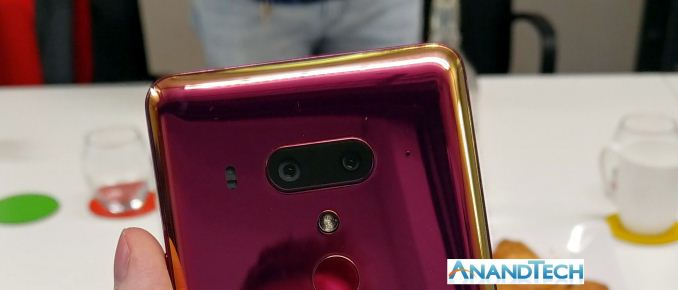

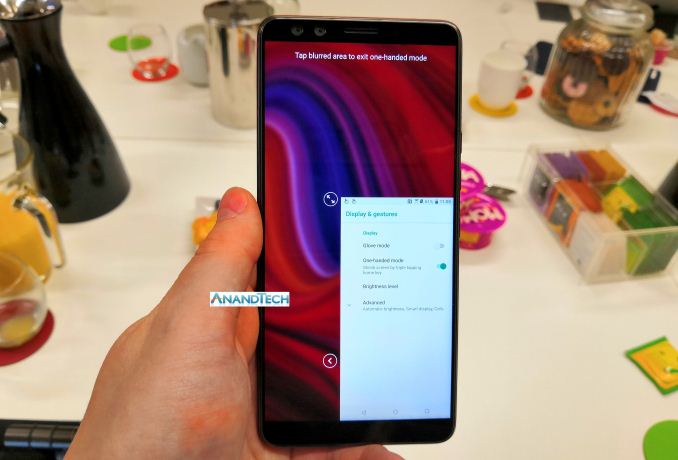

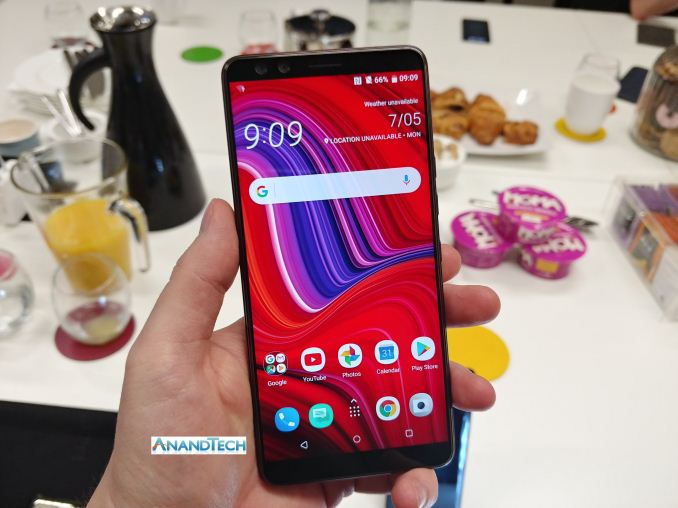

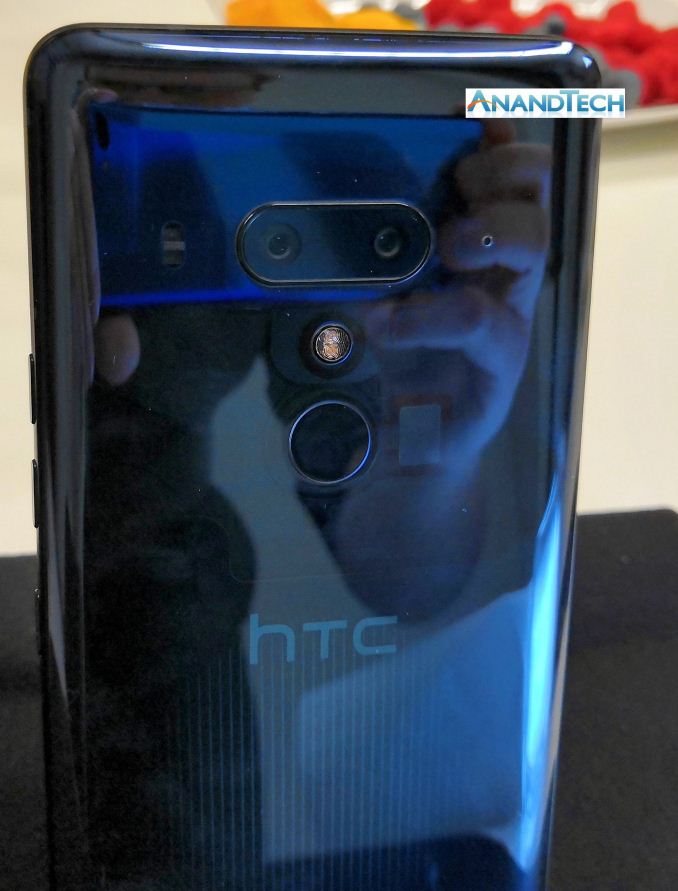








47 Comments
View All Comments
piroroadkill - Wednesday, May 23, 2018 - link
Oh look, another enormous, slippery phone lacking basic features like a headphone jack. That rear finish is going to be ugly in no time, from fingerprints and scratches.BedfordTim - Wednesday, May 23, 2018 - link
They want you to chuck it in a bin after a few months and buy another one. If it lasted what would they sell you next year?1_rick - Wednesday, May 23, 2018 - link
They're going to have to learn the same lesson the computer makers and more recently the tablet makers have: people aren't going to buy $800 phones every year.babadivad - Wednesday, May 23, 2018 - link
No headphone Jack, No Buy.flyingpants1 - Sunday, May 27, 2018 - link
Same with LOUD front stereo speakers. The blackberry passport speaker is better than most portable bluetooth speakers.I could live without it, but a $20 microSD card allows me to buy a lower-end model and saves me money. For shooting 4k video, storing full seasons of TV, etc. why the hell not? They're ridiculously tiny.
I don't need removable battery, but I do need it to be easy to replace with a screwdriver. I don't necessarily need wireless charging, but frictionless contactors (like a magsafe) would be good, so my USB-C port doesn't wear out.
Tams80 - Thursday, May 24, 2018 - link
And some of these companies wonder why their phones don't sell well.imaheadcase - Thursday, May 24, 2018 - link
If a headphone jack is a deciding factor in buying a phone, maybe you shouldn't be having a SMARTphone to begin with. Zero reason to need headphone jack anymore.Lord of the Bored - Thursday, May 24, 2018 - link
Headphones are still a thing people use. And likely will be until wireless neural interfaces mean our portable computers can beam sound directly into our brains.GIVEN that headphones are still a thing, why would I want to limit myself to the small subset of headphones with USB-C and Bluetooth connections, particularly when USB-C is NOT represented in the higher quality portion of the spectrum, and Bluetooth CAN'T be due to bandwidth limitations?
Yes, I can carry around an adapter to give me a real headphone jack compatible with any industry-standard audio device and then I can hook my phone up to a nice set of headphones(or my stereo's line-in port), perfectly replicating the experience of a GBA SP circa 2005. But I SHOULDN'T HAVE TO. Also, I might want to charge my phone while I'm listening to music. I do this regularly.
What I'm saying is that newer is not inherently better.
USB-C audio offers no technical advantages over a standard headphone jack, while creating the disadvantages of incompatibility with most of the industry and "headphones block the charger port". And really, that should make it a non-starter, but manufacturers want to save five cents on a connector so they're spending millions to convince people that the headphone jack needs to move to the charger port.
Bluetooth certainly offers an advantage by being wireless, but it comes with the disadvantages of reduced audio quality and yet another battery to charge.
There are very good reasons to have a headphone jack. If forced to get a phone with no headphone jack, I will also be forced to get a USB-C splitter as well as a headphone dongle.
Incidentally, I say all this as someone who uses both standard headphones as well as Bluetooth headphones regularly.
silverblue - Thursday, May 24, 2018 - link
Google messed up codec support with Oreo, so what sounded good over Bluetooth before now sounds clipped. The quality difference from using an AUX cable instead of Bluetooth with my U11 is quite pronounced.philehidiot - Friday, May 25, 2018 - link
Lord of the Bored - I agree with every word. I regularly charge whilst using headphones, I've invested in reasonably high end headphones with a 3.5mm jack and I am NOT spending more money on dongles, etc to fix a problem that has been created artificially. All the excuses they give for ditching the jack are rubbish. If I'm spending a fortune on a phone, the odds are I intend to use it as a mini portable computer. That means I want as many connectivity options as possible to maximise usefulness and versatility. That means SD slot, 3.5mm jack (some people use this for external microphones and hell, you can even get a radiation meter that interfaces via this port) as well as USB. Bluetooth doesn't solve the issue as it's frankly fickle (the number of connection issue I regularly run into reminds me of the old days of networking), is something else to charge and if it goes dead you can't do anything with them, the headphones are something else expensive to lose and the audio quality is variable depending on external factors and sub par except in the best of conditions (and even then it's just not as good as a cabled device).Add to that this obsession with glass phones which smash and crack to the point where you pretty much HAVE to get a case and you end up with a design that is clearly there to impress reviewers. Everyone else will not benefit from the poncy design as they will put it in a robust case as something you use multiple times a day, every day for two years is gonna get dropped. The only reasonable conclusion therefore is that they want the journalists who review these devices and won't use a case to really love the design and so they rave about it, selling more phones, rather than caring about what the end user is going to find practical.